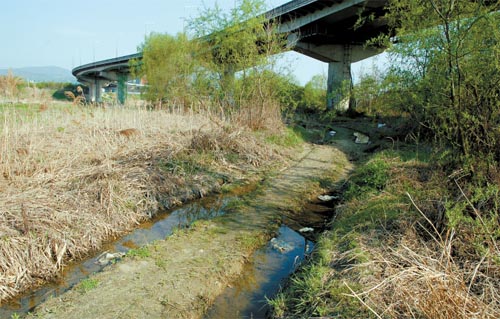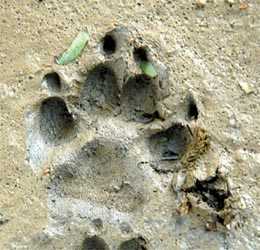Away from the bikers and hikers, a humble avian refuge

Tan Stream starts near Yongin City and flows into the Han River around southern Seoul. Seoul designated this 6.7-kilometer (4-miles) area as an Ecological Preserve. [JoongAng Ilbo]
“The special bike roads were established as an environment-friendly project as more and more people use bikes as a means of transportation,” said Lee Byung-woo, a member of the Wild Animal Group accompanying the team. “But such roads are in fact harming the environment as they become a barrier blocking wild animals from going down to the stream.”
Luckily, the western part of the riverbank has no bike roads, or even hiking trails. So we had to find our own way. Soon we came upon a plover bird bathing in a little pond, left after rainfall a few days earlier. Later, a magpie dropped down from the trees to quench its thirst.
After only 10 minutes of walking along the western part of the river, the team saw a Korean crow-tit. As this bird is used in one Korean proverb for its short legs, the team could not help but focus on its legs. And the proverb was indeed true.

A raccoon print. [JoongAng Ilbo]
Lee said that there were two reasons birds seem to gather in Tancheon. “Birds love this place not only because water and prey are relatively abundant, but also because there are sand islets in the middle of the stream.”
A sand perch is in fact a perfect spot for a bird to stand and look for food, while protecting themselves from natural enemies such as cats. Through binoculars, a snipe and a white-faced wagtail could be seen drinking water while standing on one such sandy refuge.
Except for a dead raccoon, we didn’t see any mammals. But we did see raccoon excrement accumulating in one area, showing that the species still seems to be thriving. Raccoon footprints were also visible, with the characteristic four toenails. One of the members said that the area could be a habitat for a raccoon family, because of the presence of the carcass, excrement and footprints.
The team ended our explorations after finding a skull of an animal that appeared to have come from a wildcat.










with the Korea JoongAng Daily
To write comments, please log in to one of the accounts.
Standards Board Policy (0/250자)